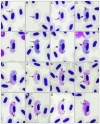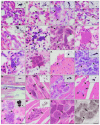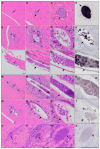Exo-erythrocytic development of two Haemoproteus species (Haemosporida, Haemoproteidae), with description of Haemoproteus dumbbellus, a new blood parasite of bunting birds (Emberizidae)
- PMID: 37263375
- PMCID: PMC7615398
- DOI: 10.1016/j.ijpara.2023.02.009
Exo-erythrocytic development of two Haemoproteus species (Haemosporida, Haemoproteidae), with description of Haemoproteus dumbbellus, a new blood parasite of bunting birds (Emberizidae)
Abstract
Avian haemosporidians are widespread parasites categorized into four families of the order Haemosporida (Apicomplexa). Species of the subgenus Parahaemoproteus (genus Haemoproteus) belong to the Haemoproteidae and are transmitted by Culicoides biting midges. Reports of death due to tissue damage during haemoproteosis in non-adapted birds have raised concerns about these pathogens, especially as their exo-erythrocytic development is known for only a few Haemoproteus spp. More research is needed to better understand the patterns of the parasites' development in tissues and their impact on avian hosts. Yellowhammers Emberiza citrinella (Emberizidae) and common house martins Delichon urbicum (Hirundinidae) were screened for Haemoproteus parasites by microscopic examination of blood films and PCR-based testing. Individuals with single infection were selected for histological investigations. H & E-stained sections were screened for detection and characterization of the exo-erythrocytic stages, while chromogenic in situ hybridization (CISH) and phylogenetic analysis were performed to confirm the Haemoproteus origin and their phylogenetic relationships. Haemoproteus dumbbellus n. sp. was discovered in Emberiza citrinella single-infected with the lineage hEMCIR01. Meronts of H. dumbbellus n. sp. developed in various organs of five of six tested individuals, a pattern which was reported in other Haemoproteus species clustering in the same clade, suggesting this could be a phylogenetic trait. By contrast, in Delichon urbicum infected with the Haemoproteus lineage hDELURB2, which was linked to the more distantly related parasite Haemoproteus hirundinis, only megalomeronts were found in the pectoral muscles of two of six infected individuals. All exo-erythrocytic stages were confirmed to be Haemoproteus parasites by CISH using a Haemoproteus genus-specific probe. While the development of meronts seems to be typical for species of the clade containing H. dumbbellus, further investigations and data from more species are needed to explore whether a phylogenetic pattern occurs in meront or megalomeront formation.
Keywords: Avian haemosporidians; Chromogenic in situ hybridization; Haemoproteus; Haemoproteus dumbbellus n. sp.; Megalomeronts; Meronts.
Copyright © 2023 The Author(s). Published by Elsevier Ltd.. All rights reserved.
Figures





Similar articles
-
Co-infecting Haemoproteus species (Haemosporida, Apicomplexa) show different host tissue tropism during exo-erythrocytic development in Fringilla coelebs (Fringillidae).Int J Parasitol. 2024 Jan;54(1):1-22. doi: 10.1016/j.ijpara.2023.07.004. Epub 2023 Aug 19. Int J Parasitol. 2024. PMID: 37598774
-
Unravelling the patterns of exo-erythrocytic development of Haemoproteus parasites (Haemoproteidae, Haemosporida), with a case of abortive tissue stages in a naturally infected bird.Int J Parasitol. 2025 Jan;55(1):15-26. doi: 10.1016/j.ijpara.2024.10.002. Epub 2024 Oct 10. Int J Parasitol. 2025. PMID: 39393755
-
Patterns of Haemoproteus majoris (Haemosporida, Haemoproteidae) megalomeront development.Acta Trop. 2020 Dec;212:105706. doi: 10.1016/j.actatropica.2020.105706. Epub 2020 Sep 18. Acta Trop. 2020. PMID: 32956638
-
Keys to the avian Haemoproteus parasites (Haemosporida, Haemoproteidae).Malar J. 2022 Sep 19;21(1):269. doi: 10.1186/s12936-022-04235-1. Malar J. 2022. PMID: 36123731 Free PMC article. Review.
-
Exo-erythrocytic development of avian malaria and related haemosporidian parasites.Malar J. 2017 Mar 3;16(1):101. doi: 10.1186/s12936-017-1746-7. Malar J. 2017. PMID: 28253926 Free PMC article. Review.
Cited by
-
Unexpected absence of exo-erythrocytic merogony during high gametocytaemia in two species of Haemoproteus (Haemosporida: Haemoproteidae), including description of Haemoproteus angustus n. sp. (lineage hCWT7) and a report of previously unknown residual bodies during in vitro gametogenesis.Int J Parasitol Parasites Wildl. 2024 Jan 9;23:100905. doi: 10.1016/j.ijppaw.2024.100905. eCollection 2024 Apr. Int J Parasitol Parasites Wildl. 2024. PMID: 38292244 Free PMC article.
-
An Overview of the Neglected Modes of Existence in Avian Haemosporidian Parasites.Microorganisms. 2025 Apr 25;13(5):987. doi: 10.3390/microorganisms13050987. Microorganisms. 2025. PMID: 40431160 Free PMC article. Review.
-
Prevalence, morphological and molecular characterization of Leucocytozoon macleani (Apicomplexa: Haemosporida) from chickens in Thailand.Parasite. 2025;32:50. doi: 10.1051/parasite/2025043. Epub 2025 Aug 5. Parasite. 2025. PMID: 40763271 Free PMC article.
-
Leucocytozoon infections in tits (Aves, Paridae): blood and tissue stages investigated using an integrative approach.Parasite. 2025;32:13. doi: 10.1051/parasite/2025007. Epub 2025 Feb 21. Parasite. 2025. PMID: 39982000 Free PMC article.
-
A new blood parasite of the accentor birds: description, molecular characterization, phylogenetic relationships and distribution.Parasitology. 2024 Sep;151(10):1163-1173. doi: 10.1017/S0031182024000878. Epub 2024 Nov 15. Parasitology. 2024. PMID: 39542856 Free PMC article.
References
-
- Atkinson CT, Greiner EC, Forrester DJ. Pre-erythrocytic development and associated host responses to Haemoproteus meleagridis (Haemosporina: Haemoproteidae) in experimentally infected domestic turkeys. J Protozool. 1986;33:375–381. - PubMed
-
- Bennett GF, Peirce MA, Ashford RW. Avian haematozoa: Mortality and pathogenicity. J Nat Hist. 1993;27:993–1001. doi: 10.1080/00222939300770621. - DOI
Publication types
MeSH terms
Substances
LinkOut - more resources
Full Text Sources
Miscellaneous

